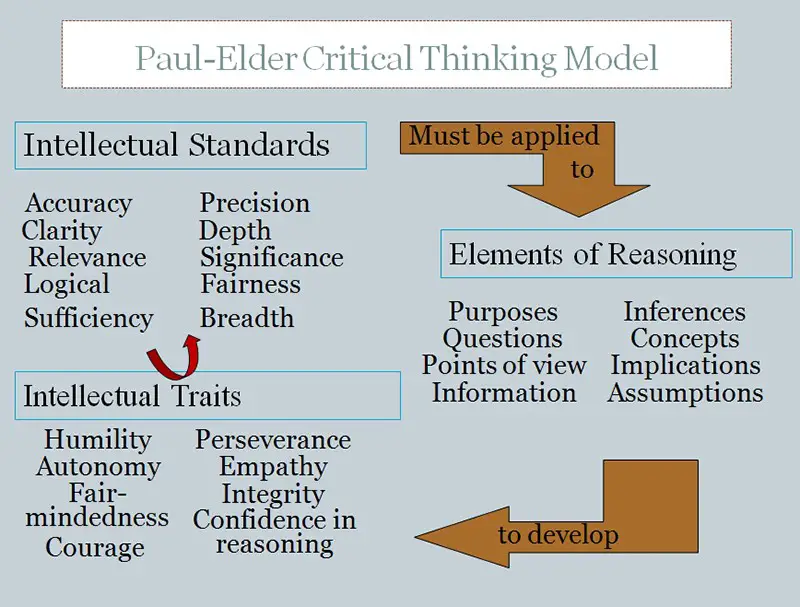People live their days dealing with all sorts of problems, from the awfully mundane to the considerably urgent. Oftentimes, a sound decision-making process is required to come up with the most satisfying solution. While it makes sense to look back on your previous experiences and similar case studies to help you face your current situation, that may not always be the best strategy for solving your problems.
It may be true that some experiences are universal, but the tiny details that surround each situation will always be unique. Therefore, it is necessary to apply critical thinking skills when attacking a problem, even if you think that “it’s nothing new”. Besides, if you really claim to have learned anything at all, you shouldn’t even be dealing with the very same thing again.
Universal Intellectual Standards
The universal intellectual standards are the bread and butter of all critical thinking processes. These are used as basis for examining the quality of one’s thoughts and reasonings. The 9 basic ones are as follows:
- Clarity – Can this be understood?
- Can you please expound?
- Can you cite an example?
- Can you demonstrate what you’re saying?
- Accuracy – Is this factual?
- How do you check for errors?
- How can you verify its authenticity?
- How can you be sure of this?
- Precision – What are all the details?
- Can you tell me more about it?
- Can you make things more specific?
- Can you go through all of the particulars?
- Relevance – How are things connected?
- What is its relation to the situation?
- What is its bearing to the problem?
- How can this information help?
- Depth – How complex is this problem?
- What makes this issue difficult?
- What kind of complexities are you facing?
- What makes this a struggle?
- Breadth – What are the other angles?
- Do you have to change how you look at the problem?
- Do you have to take another perspective into account?
- Do you have to explore other possibilities?
- Logic – Does everything make sense?
- Does everything look in place?
- Does this part support all the other parts?
- Does your conclusion match the actual data?
- Significance – What are the things that really matter?
- What are the most important facts that you need to know?
- What factor trumps everything else?
- What should you really focus on?
- Fairness – Is this fair for all involved?
- Am I really doing this for the good of everyone?
- Am I just pushing my own agenda?
- What will each party get out of this?
Elements of Thought and Intellectual Traits
All of our thoughts are made up of 8 elements. They may not exactly arise in this exact order, but it’s a rough guide for learning how our thoughts come about. These are:
- Purpose – What is my goal?
- Questions – What am I trying to figure out?
- Information – What data, evidences, or facts do I have?
- Interpretations or inferences – What can I conclude based on facts?
- Concepts – What is the general idea behind my reasoning?
- Assumptions – What are my predetermined beliefs?
- Implications or consequences – What would happen if I make this choice?
- Point of view – What do I stand for? What is my focus?
When we consistently apply the universal intellectual standards to our thought formation, we further strengthen and solidify our intellectual traits. These traits include: humility, courage, empathy, autonomy, integrity, perseverance, confidence in reason, and fair-mindedness. As you may notice, most of these traits do not necessarily reflect the mind’s intellectual capacity on their own. However, putting them together allows an individual to cultivate a mind that is able to think beyond the present tangibles.
The Paul-Elder Critical Thinking Framework: Putting It All Together


The various elements of thoughts or reasoning aim to help us understand what makes our thoughts the way they are. If we don’t choose to develop our intellectual traits and examine our intellectual standards, we may remain stuck in beliefs that are bad for us in the long run.
The great thing about critical thinkers is that they are able to accept that some of what they know are not built on solid ground. They may initially feel attacked when someone refutes a belief that they’ve poured their soul into, but once rationality kicks in, they are always eager to expand their views. They take the time to learn how to feel unashamed about changing their thoughts when they discover other valid perspectives.
6-Step Critical Thinking Framework: Applying the Paul-Elder Model
Once we know the Paul-Elder Critical Thinking Framework by heart, it now becomes a lot easier to go about the critical thinking and decision-making process. It makes us more prepared to do the necessary steps in order to move our cause forward. These steps are:
- Knowledge
- What is the issue that I need to solve?
- Why is a solution needed?
- Comprehension
- What are the facts of the matter?
- How do I understand the situation?
- Application
- How are things interrelated?
- How do I use my resources to address the facts?
- Analysis
- What are the hurdles that I need to face?
- What are the strongest and the weakest points of this whole issue?
- What kinds of effects are we dealing with / will be dealing with?
- Synthesis
- Given all the data and analyses, how do I solve the problem?
- What are my options?
- How do I evaluate my options?
- Action
- How do I translate my final decision into actionable steps?
- How will I get things done?
In any situation, we can’t simply think that we already know what to do just because we’ve seen enough. While familiarity can help us strategize, each new problem has subtle nuances that sets it apart from all the others that came before it. We will need to constantly go after new information so that we can integrate them into an improved game plan that has a higher chance of success.





